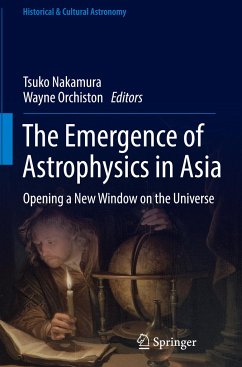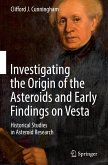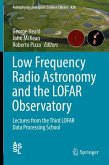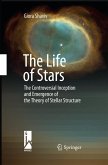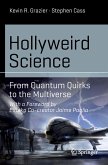The Emergence of Astrophysics in Asia
Opening a New Window on the Universe
Herausgegeben:Nakamura, Tsuko; Orchiston, Wayne
The Emergence of Astrophysics in Asia
Opening a New Window on the Universe
Herausgegeben:Nakamura, Tsuko; Orchiston, Wayne
- Gebundenes Buch
- Merkliste
- Auf die Merkliste
- Bewerten Bewerten
- Teilen
- Produkt teilen
- Produkterinnerung
- Produkterinnerung
This book examines the ways in which attitudes toward astronomy in Australia, China, India, Indonesia, Japan, South Korea, New Zealand, Taiwan, Thailand and Uzbekistan have changed with the times.
The emergence of astrophysics was a worldwide phenomenon during the late nineteenth and early twentieth centuries, and it gradually replaced the older-style positional astronomy, which focused on locating and measuring the movements of the planets, stars, etc.. Here you will find national overviews that are at times followed by case studies of individual notable achievements. Although the emphasis…mehr
![Investigating the Origin of the Asteroids and Early Findings on Vesta Investigating the Origin of the Asteroids and Early Findings on Vesta]() Clifford J. CunninghamInvestigating the Origin of the Asteroids and Early Findings on Vesta74,99 €
Clifford J. CunninghamInvestigating the Origin of the Asteroids and Early Findings on Vesta74,99 €![Low Frequency Radio Astronomy and the LOFAR Observatory Low Frequency Radio Astronomy and the LOFAR Observatory]() Low Frequency Radio Astronomy and the LOFAR Observatory95,99 €
Low Frequency Radio Astronomy and the LOFAR Observatory95,99 €![The ABC¿s of Science The ABC¿s of Science]() Giuseppe MussardoThe ABC¿s of Science28,99 €
Giuseppe MussardoThe ABC¿s of Science28,99 €![The End of Everything The End of Everything]() Katie MackThe End of Everything9,99 €
Katie MackThe End of Everything9,99 €![The Life of Stars The Life of Stars]() Giora ShavivThe Life of Stars74,99 €
Giora ShavivThe Life of Stars74,99 €![Hollyweird Science Hollyweird Science]() Kevin R. GrazierHollyweird Science22,99 €
Kevin R. GrazierHollyweird Science22,99 €![Limiting Outer Space Limiting Outer Space]() Limiting Outer Space74,99 €
Limiting Outer Space74,99 €-
-
-
The emergence of astrophysics was a worldwide phenomenon during the late nineteenth and early twentieth centuries, and it gradually replaced the older-style positional astronomy, which focused on locating and measuring the movements of the planets, stars, etc.. Here you will find national overviews that are at times followed by case studies of individual notable achievements. Although the emphasis is on the developments that occurred around 1900, later pioneering efforts in Australian, Chinese, Indian and Japanese radio astronomy are also included.
As the first book ever published on the early development of astrophysics in Asia, the authors fill a chronological and technological void. Though others have already written about earlier astronomical developments in Asia,and about the recent history of astronomy in various Asian nations, no one has examined the emergence of astrophysics, the so-called 'new astronomy' in Asia during the late nineteenth and early twentieth centuries.
- Produktdetails
- Historical & Cultural Astronomy
- Verlag: Springer / Springer International Publishing / Springer, Berlin
- Artikelnr. des Verlages: 978-3-319-62080-0
- 1st ed. 2017
- Seitenzahl: 896
- Erscheinungstermin: 24. November 2017
- Englisch
- Abmessung: 241mm x 160mm x 50mm
- Gewicht: 1566g
- ISBN-13: 9783319620800
- ISBN-10: 3319620800
- Artikelnr.: 48369693
- Historical & Cultural Astronomy
- Verlag: Springer / Springer International Publishing / Springer, Berlin
- Artikelnr. des Verlages: 978-3-319-62080-0
- 1st ed. 2017
- Seitenzahl: 896
- Erscheinungstermin: 24. November 2017
- Englisch
- Abmessung: 241mm x 160mm x 50mm
- Gewicht: 1566g
- ISBN-13: 9783319620800
- ISBN-10: 3319620800
- Artikelnr.: 48369693

